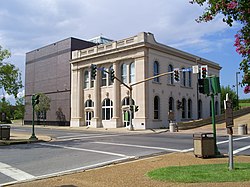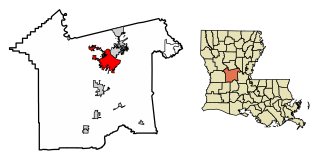
Alexandria is the ninth-largest city in the state of Louisiana and is the parish seat of Rapides Parish, Louisiana, United States. It lies on the south bank of the Red River in almost the exact geographic center of the state. It is the principal city of the Alexandria metropolitan area which encompasses all of Rapides and Grant parishes. Its neighboring city is Pineville. In 2010, the population was 47,723, an increase of 3 percent from the 2000 census.

The Des Moines Art Center is an art museum with an extensive collection of paintings, sculpture, modern art and mixed media. It was established in 1948 in Des Moines, Iowa.
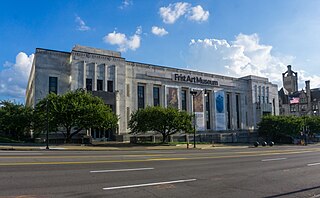
The Frist Art Museum, formerly known as the Frist Center for the Visual Arts, is an art exhibition hall in Nashville, Tennessee, housed in the city's historic U.S. Post Office building, which is listed on the National Register of Historic Places.

The Ann Arbor Hands-On Museum, located in Ann Arbor, Michigan, United States, specializes in interactive exhibits with the goal of helping both children and adults discover the scientist within them by promoting science literacy through experimentation, exploration, and education.

Louisiana State University of Alexandria is a public college in Alexandria, Louisiana. It offers undergraduate degrees in numerous disciplines. The university is a unit of the LSU System and operates under the auspices of the Louisiana Board of Regents. As of fall 2017, LSUA had an enrollment of 3,378 students which is recorded as the highest in the university's history. The institution is located on the grounds of the former Oakland Plantation some eight miles south of downtown Alexandria. The campus boasts many majestic oaks dating from the nineteenth century.

Old School Square is located in a historic area at 51 North Swinton Avenue in Delray Beach, Florida, United States. The 5-acre site is at the corner of Atlantic Avenue and Swinton Avenue, anchoring Delray's downtown shopping district. The campus includes restored early 20th century school buildings, formerly Delray Elementary and Delray High School, which were re-adapted as the Cornell Art Museum, Crest Theatre and Fieldhouse. The campus also includes the Pavilion in the center grounds, which is an outdoor entertainment stage with grass seating area, as well as the Old School Square Park just to the east. A City of Delray Beach parking garage is located adjacent to the park.

The Louisiana State Museum (LSM), founded in New Orleans in 1906, is a statewide system of National Historic Landmarks and modern structures across Louisiana, housing thousands of artifacts and works of art reflecting Louisiana's legacy of historic events and cultural diversity.

The Susquehanna Art Museum is a non-profit art museum in the United States, located in Midtown Harrisburg, Pennsylvania, the state's capital.

The Louisiana History Museum is located in the historic downtown portion of Alexandria, Louisiana, USA, near the Red River. It showcases the social evolution of all of Louisiana, but centers on the history of Central Louisiana, Rapides Parish, and Alexandria. Major exhibit areas deal with Native Americans, Louisiana geography, politics, health care, farming, and the impact of war.

The culture of San Antonio reflects the history and culture of one of the state's oldest and largest cities straddling the regional and cultural divide between South and Central Texas. Historically, San Antonio culture comes from a blend of Central Texas and South Texas (Southwestern) culture. Founded as a Spanish outpost and the first civil settlement in Texas, San Antonio is heavily influenced by Mexican American culture due to Texas formerly being part of Mexico and, previously, the Spanish Empire. The city also has significant German, Anglo, and African American cultural influences. San Antonio offers a host of cultural institutions, events, restaurants and nightlife in South Texas for both residents and visitors alike.
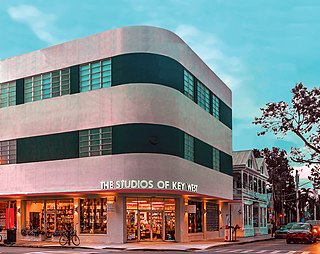
The Studios of Key West is a center for the arts in Key West, an island community at the southernmost tip of the Florida Keys. Established in 2006 as a nonprofit cultural organization, The Studios works to promote multidisciplinary arts, to provide artist-in-residency opportunities for artists worldwide, and to maintain long-term studio spaces dedicated to Florida Keys artists. The organization publishes a yearly catalog of activities and maintains an extensive website at TSKW.org.

The Monongalia Arts Center, or MAC, is located in Morgantown, West Virginia near the campus of West Virginia University. The MAC opened to the public in 1978 as a non-profit arts and culture center, which it remains today. The MAC's mission is "to provide a home for the arts where the work of visual and performing artists is showcased and interest in the arts is nurtured through ongoing educational programs." The building hosts two galleries, a theatre for the performing arts, and is undergoing production on other projects, including an Internet radio station and the establishment of the Tanner Theatre as a regular venue for touring bands. The building is also recognized on the National Register of Historic Places.

The Beauregard Parish Training School in DeRidder, Louisiana, was a school for black students and black teachers in training. The two school buildings, located on the original property at the corner of Martin Luther King Drive and Alexandria Street, were the first African-American related structures in southwestern Louisiana to be listed in the National Register of Historic Places, on March 1, 1996.
Sun Valley Museum of Art is the oldest arts organization in central Idaho’s Wood River Valley. Founded in 1971, The Museum has grown from a few people presenting classes and events to an organization that has over 25,000 people attend events annually. More than half of those who attended, attended free programs.
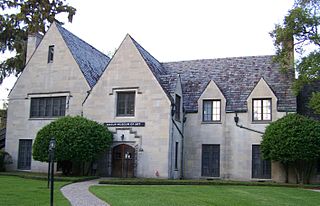
The Masur Museum of Art in Monroe, Louisiana in the United States, is the largest visual arts museum in northeast Louisiana. It is in the former home of the Masur family, the Masur House, also known as the Slagle-Masur House, which is listed on the National Register of Historic Places. The building, constructed in modified Tudor style in 1914, was listed on the National Register in 1982 for its architecture. In 1963 it was given to the city of Monroe by the Masur family.
Zillman Art Museum-University of Maine (ZAM) is an art museum in downtown Bangor, Maine. It is part of the University of Maine, which is located in nearby Orono, Maine. The University of Maine Art Collection was established in 1946, under the leadership of Vincent Hartgen. As the initial faculty member of the Department of Art and curator of the art collection, Hartgen's goal was to provide the people of Maine with significant opportunities to experience and learn about the visual arts and their diverse histories and cultural meanings.

Founded in 1954, The Art League, Inc. a 501(c)(3) organization, is a multi-service organization for visual artists, as well as the founding organization of the Torpedo Factory Art Center in Alexandria, Virginia. In Old Town Alexandria, Virginia, The Art League offers exhibit opportunities for artists through its gallery, fine art education through a school, and outreach programs to the local community. The Art League was selected for the 2010-11 Catalogue for Philanthropy as "one of the best small charities in the Washington, DC Region."

The Longview Museum of Fine Arts (LMFA) is an art museum in downtown Longview, Texas. It was founded in 1958 by the Junior Service League of Longview. Since 1998, it has been on Tyler Street in downtown Longview.

CAIXA Cultural São Paulo is one of CAIXA Cultural network's units, a complex of cultural centers located in different capital cities in Brazil, maintained by Caixa Econômica Federal. In operation since 1989, the São Paulo unit is located in the Sé Building, the bank's former regional headquarters, inaugurated in 1939 by Getúlio Vargas. The building is an important example of Art Deco architecture in São Paulo and is listed as a city heritage site. Caixa Cultural also runs a second center in São Paulo, the Vitrine da Paulista Gallery, on the first floor of Conjunto Nacional.
